Overview
Opportunities for innovation in Latin America are significantly driven by technological advancements, a burgeoning entrepreneurial spirit, and supportive government policies, particularly within sectors such as healthcare and digital connectivity. This article underscores these developments through notable examples, including:
- The establishment of tech startups in Brazil
- The establishment of tech startups in Mexico
- The establishment of tech startups in Argentina
- Initiatives like bioaccess™, which enhance clinical research and address the region's unique health challenges
These instances not only illustrate the potential for economic growth but also highlight the capacity for social change, emphasizing the critical role of collaboration in advancing these efforts.
Introduction
Latin America stands on the cusp of a transformative wave in innovation, propelled by a convergence of technological advancements, an entrepreneurial surge, and supportive government policies. The region is witnessing a burgeoning number of tech startups, particularly in Brazil, Mexico, and Argentina, positioning itself as a formidable player on the global stage, especially in clinical research.
Initiatives like bioaccess™ are enhancing healthcare delivery and streamlining clinical trials, demonstrating that Latin America is ripe with opportunities for groundbreaking advancements. This article explores the dynamic landscape of innovation across various sectors, highlighting how the region harnesses technology to tackle pressing social and economic challenges, ultimately paving the way for a brighter, more connected future.
The Landscape of Innovation in Latin America
The region is witnessing remarkable opportunities for innovation in Latin America, driven by technological advancements, a burgeoning entrepreneurial spirit, and proactive government policies. In 2025, the region has experienced a notable surge in tech startups, particularly in Brazil, Mexico, and Argentina, where dynamic ecosystems are taking shape. This growth is not merely a local phenomenon; it positions the region as a formidable competitor on the global stage, especially in clinical research, creating substantial opportunities for innovation in Latin America.
For instance, bioaccess™ has established partnerships with Caribbean Health Group and IDx Technologies, aiming to position Barranquilla as a premier location for clinical trials in the region. This initiative includes identifying South American ophthalmology centers for AI-based disease detection collaboration and enhancing clinical trial ambulatory services in Colombia, achieving over a 50% reduction in recruitment time and 95% retention rates. The initiative has garnered strong support from Colombia's Minister of Health, further solidifying its significance.
The emergence of unicorns—startups valued at over $1 billion—highlights the opportunities for innovation in Latin America, which can catalyze economic growth and foster social change. Statistics indicate that by 2053, the percentage of the population aged 65 years and older in Latin America is projected to reach 20.6%, underscoring the urgent need for opportunities for innovation in Latin America to develop innovative solutions in healthcare and technology that address the challenges of an aging demographic. Successful tech startups in the region are already responding to these needs, driving advancements in medical technology and other sectors.
As Marco Llinás, Director of ECLAC’s Division of Production, Productivity and Management, emphasizes, "It proposes four lines of work that aim to better connect STI efforts with the productive development policies of countries and their territories."
Recent case studies, such as the Sustainable Rural and Small Towns Water and Sanitation Project in Haiti, demonstrate how innovative approaches can significantly enhance public health and access to essential services, benefiting over 565,000 people. This project exemplifies the broader trend of leveraging technology to solve pressing social issues, particularly in the context of an aging population that requires improved healthcare solutions.
Moreover, the aging population necessitates changes to pension systems without jeopardizing macroeconomic stability, further highlighting the significance of creativity in tackling these challenges. As we delve deeper into the creative environment of the southern continent, it is essential to recognize the distinct challenges and the opportunities for innovation in Latin America that characterize this vibrant region. Current trends indicate a robust growth trajectory for tech startups, supported by a favorable environment for creativity and collaboration, with bioaccess® leading the charge in facilitating clinical research for Medtech startups across the continent, revealing opportunities for innovation in Latin America.
bioaccess® provides essential services including regulatory approval, clinical research site activation, subject recruitment, and trial data management, ensuring a comprehensive approach to advancing medical device research.
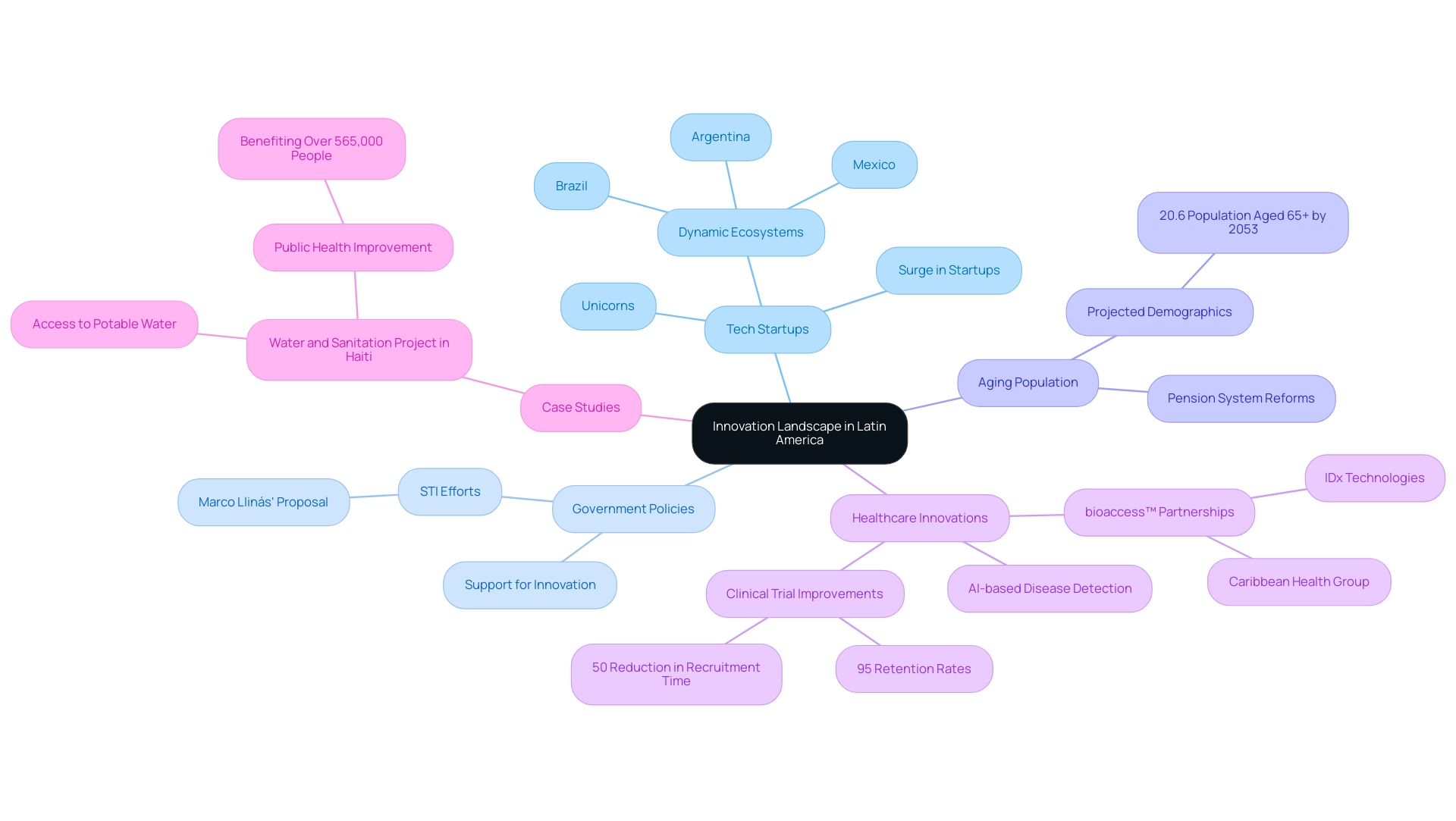
Bridging the Digital Divide: Technological Innovations in Connectivity
Technological advancements in connectivity are crucial for bridging the digital divide in Latin America. Initiatives such as Amazon's Project Kuiper are poised to transform internet access by providing reliable, high-speed connectivity to underprivileged areas, thereby enabling millions to engage with the digital landscape. This surge in connectivity is not merely a convenience; it is a catalyst for innovation, empowering individuals and businesses to access vital information, collaborate effectively, and integrate into the global economy.
Marketers should expect an average engagement rate of below 2 percent on Facebook posts, highlighting the need for improved connectivity to enhance digital engagement. Moreover, the expansion of broadband infrastructure is essential for enhancing educational opportunities and improving healthcare delivery throughout the area. With better internet access, educational institutions can leverage online resources, fostering a more informed and skilled workforce.
In healthcare, telemedicine can thrive, allowing for timely consultations and improved patient outcomes. For instance, Learning.com highlights the critical concern of online safety for children, particularly in the context of cyberbullying, demonstrating the broader implications of connectivity on societal issues. Addressing the digital divide also creates opportunities for innovation in Latin America. By investing in connectivity, the region can drive sustainable growth across various sectors, ensuring that no community is left behind in the digital age.
As specialists stress, the significance of connectivity for progress cannot be overstated; it is the foundation upon which future advancements will be built. Furthermore, the increase in the number of social media platforms used by audiences, now averaging 6.83 platforms per month, underscores the necessity of enhanced connectivity in fostering digital engagement. As Eileen Patten noted, the margin of error for survey data can significantly impact research findings, making reliable connectivity essential for accurate data collection and analysis in clinical research.
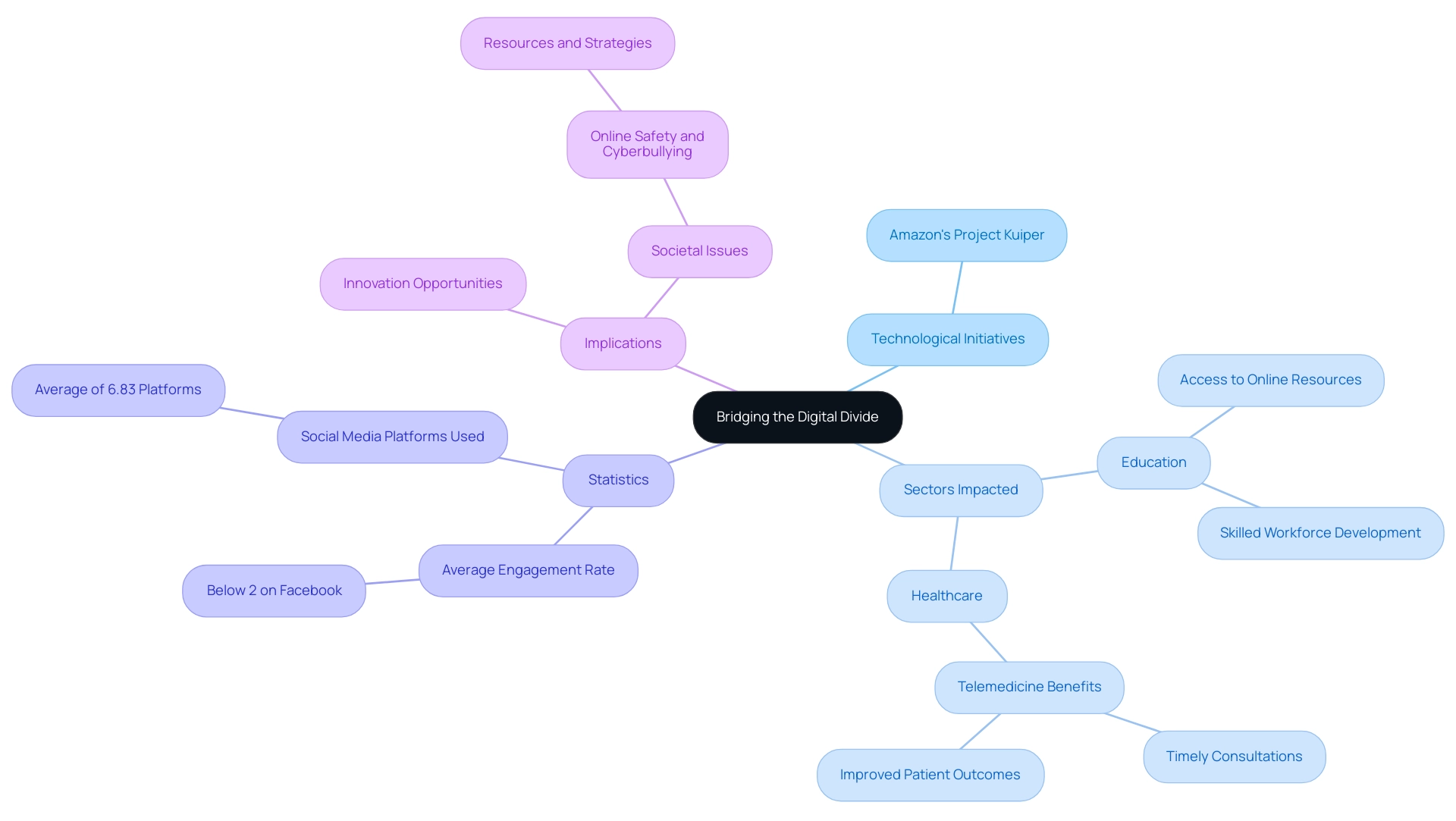
Transforming Education: The Key to Future Innovation
Education serves as a critical foundation for creativity, and the region is making significant strides in transforming its educational landscape to equip students for the demands of a digital economy. An increasing number of initiatives are dedicated to integrating technology into classrooms, enhancing STEM (Science, Technology, Engineering, and Mathematics) education, and fostering digital literacy. These programs are vital for cultivating a workforce skilled in the competencies necessary for success in a technology-driven world.
At the forefront of these efforts are teacher training and curriculum development, with statistics revealing that 94% of public school teachers reported participating in professional development or training during the 2017-2018 school year. This preparation ensures that educators can deliver high-quality instruction that aligns with the evolving needs of students. By prioritizing investments in education, Latin America is not only creating opportunities for innovation but also nurturing a generation of innovators and entrepreneurs, thereby laying the groundwork for sustained economic growth and social advancement.
Insights from the case study titled "Education Degrees" elucidate trends in employment and earnings for education degree holders, underscoring the diverse opportunities available for graduates and the necessity of understanding these trends for future educators. Successful initiatives have emerged, showcasing the potential of educational reform to spur creativity. For example, various case studies demonstrate the positive impact of targeted STEM programs in schools, which have resulted in enhanced student engagement and performance in these critical fields.
As Swasti Dharmadhikari, a research associate at Cognitive Market Research, asserts, "Education is a key driver of market transformation, and understanding its intricacies is essential for fostering innovation." As Latin America continues to embrace educational transformation, there are abundant opportunities for innovation that underscore the significance of STEM education. This preparation is crucial for enabling students to navigate and contribute to an increasingly complex and technology-oriented world, ultimately positioning the region as a competitive player in the global economy.
Moreover, the recent webinar organized by HolonIQ and the Inter-American Development Bank on digital transformation in higher education highlights current evaluations, key challenges, and essential capabilities for future enhancement in the educational landscape.
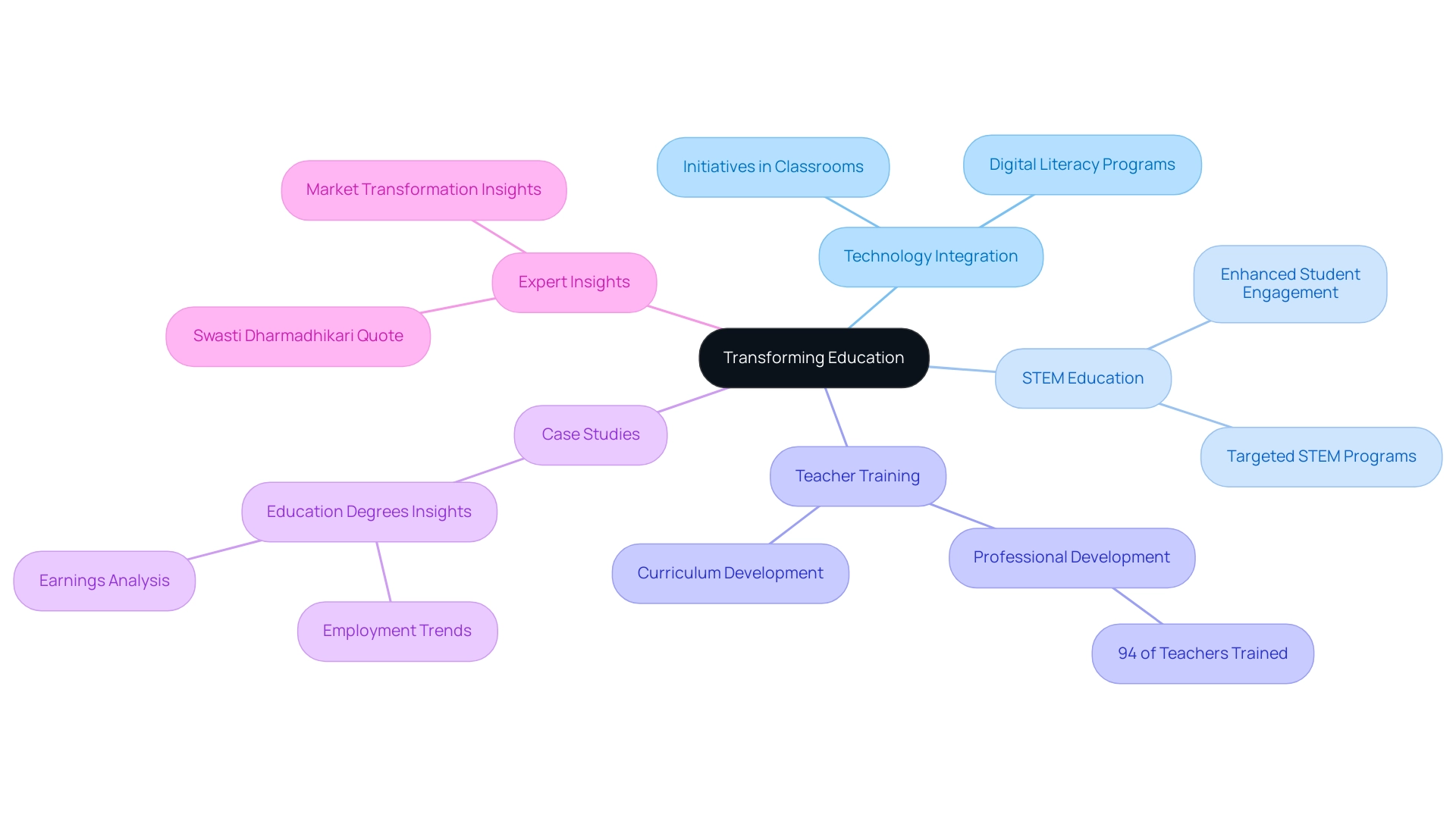
Health Innovations: Advancing Medical Technology in Latin America
Health innovations are unlocking new opportunities for advancement in Latin America, driving a remarkable transformation in medical technology. This region is witnessing a significant surge in the development of medical devices and digital health solutions, all designed to enhance patient care and optimize healthcare delivery. Companies like bioaccess™ are leading the charge, leveraging artificial intelligence, telemedicine, and wearable technologies to improve diagnostics and treatment options, reflecting a broader trend towards digital integration in healthcare.
By joining bioaccess™, you can play a pivotal role in this revolution of medical technologies poised to shape the future of healthcare. Apply today to embark on this exciting journey!
In 2025, nearly three-quarters of health system executives will prioritize enhancing consumer experience, engagement, and trust, with a strong expectation that digital tools and virtual health will be central to their strategies. Notably, only 10% of these executives are focusing on climate change and sustainability initiatives, highlighting a significant gap in strategic priorities. This shift underscores the importance of innovative solutions, revealing opportunities for innovation in Latin America to address the unique health challenges faced by the region.
Moreover, collaborations among startups, research institutions, and healthcare providers are fostering a vibrant culture of creativity that responds to local health needs. For instance, a recent workshop focused on sourcing the right medical devices emphasized the necessity of understanding the healthcare infrastructure and regulatory landscape to ensure that sourced devices meet market demands and adhere to quality standards. As Dushyanth Surakanti, Founder & CEO of Sparta Biomedical, noted from his experience with bioaccess® during its first human trial in Colombia, the potential for impactful outcomes is significant.
As Gianluca Cafagna, Senior Health Specialist for the Health, Nutrition, and Population Global Practice in the Caribbean Region, stated, "bioaccess® offers a valuable solution for companies in the medtech industry." By emphasizing health innovations, the region stands to significantly enhance public health outcomes and improve the quality of life for its citizens, positioning itself as a burgeoning hub for medical technology advancements and accelerating clinical research through services like Early-Feasibility, First-In-Human, Pilot, Pivotal, and Post-Market Follow-Up Studies.
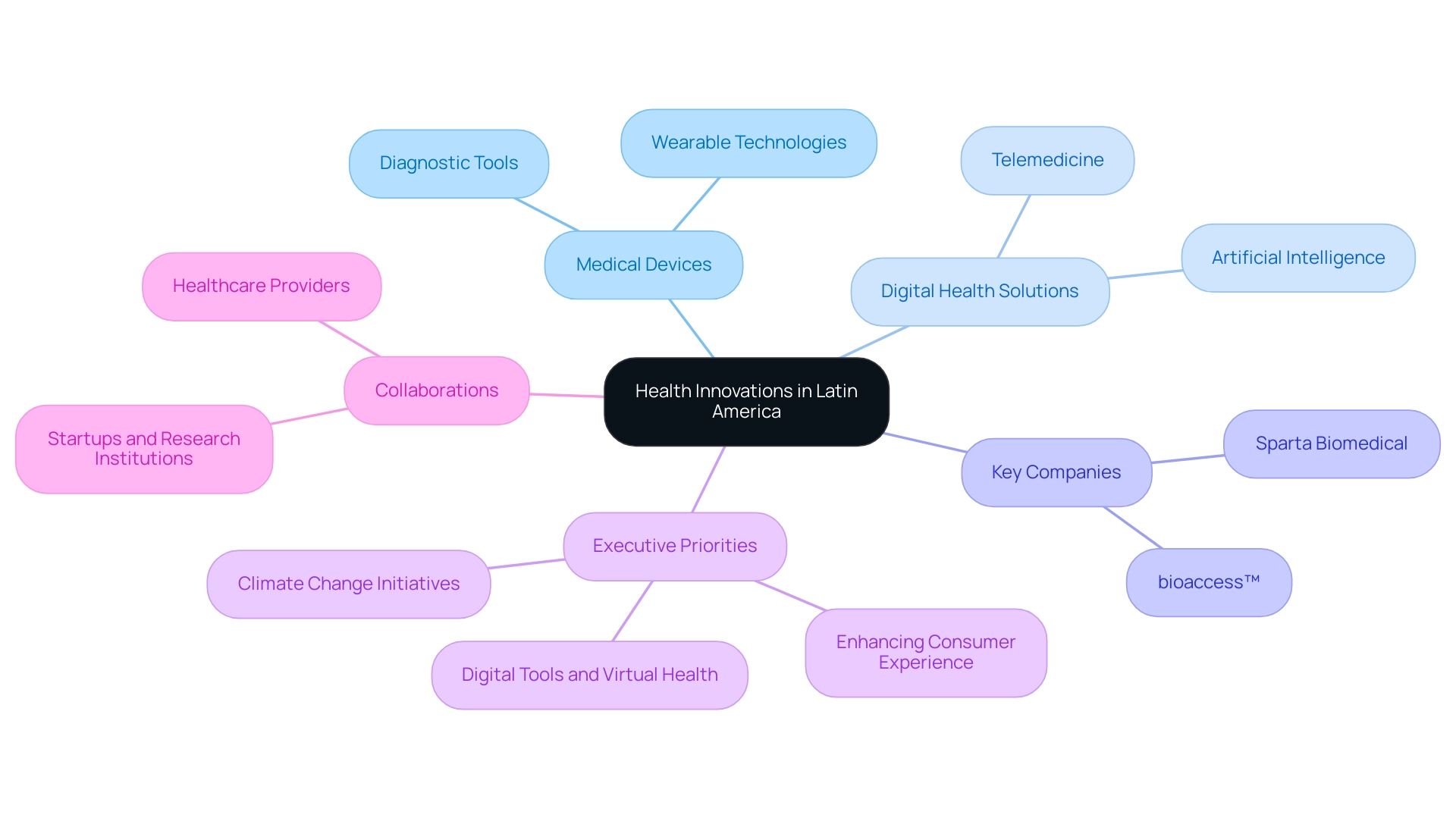
Economic Opportunities: Harnessing Innovation for Growth
There are significant opportunities for innovation in Latin America, unlocking substantial economic benefits, particularly within the clinical research sector. This region is increasingly becoming a hub for comprehensive clinical trial management services, including:
- Feasibility studies
- Site selection
- Compliance reviews
- Trial setup
- Import permits
- Project management
- Reporting
These services are crucial for facilitating the growth of Medtech clinical studies, which not only enhance healthcare outcomes but also contribute significantly to local economies through job creation, economic growth, and international collaboration.
Specifically, services like compliance reviews ensure that studies meet regulatory standards, while project management oversees the smooth execution of trials, directly impacting the efficiency and success of clinical research initiatives.
As the Medtech sector continues to expand, it parallels the remarkable growth of fintech, where startups are emerging to deliver cutting-edge solutions that enhance financial inclusion and accessibility. In 2025, the FinTech sector is expected to continue its upward trend, fueled by an increase in digital payment solutions and mobile banking services serving the unbanked population throughout the area.
Moreover, Latin America's rich natural resources present a unique opportunity for implementing sustainable practices that stimulate economic growth while addressing pressing environmental challenges. Countries like Uruguay and Chile exemplify successful fiscal sustainability efforts, reducing deficits while ensuring social security for their aging populations. For instance, the Caja Fiscal in Paraguay is projected to face a growing deficit of 1.16% of GDP by 2030, highlighting the need for strategic budget planning in the region.
This strategic approach underscores the opportunities for innovation in Latin America as essential for fostering economic resilience.
As Hernán Braña, Co-Founder & SVP of Business Development and Partnerships, notes, "This focus on sustainability not only aligns with global environmental goals but also strengthens Latin America’s economic prospects, making it a leader in green energy." By leveraging technology and sustainable methods in clinical research, the region can cultivate a diversified economy that benefits all stakeholders, presenting opportunities for innovation in Latin America and positioning itself as a leader in both economic and environmental sustainability. The integration of innovative practices across various sectors, including clinical research, is crucial for enhancing the region's competitiveness in the global market.

Collaborative Efforts: Building an Innovation Ecosystem
The collaborative efforts of various stakeholders—government entities, private sectors, academic institutions, and civil society—are crucial for establishing a robust creative ecosystem that nurtures innovation opportunities in Latin America. The significance of collaboration and knowledge exchange is paramount, as these elements are vital for cultivating an environment that promotes innovation. Initiatives such as hackathons, creativity challenges, and collaborative research projects serve as catalysts for creativity and progress.
For example, the Uepa Pay case exemplifies how collaborative creativity can transform the digital payment landscape in the Dominican Republic, streamlining operations for businesses and simplifying transactions through a versatile API for e-commerce integration.
Furthermore, the impact of creativity on financial accessibility is illustrated by Kueski, which offers online loans to underserved populations in Mexico, demonstrating how collaborative efforts can meet critical needs in this sector. The growth potential of these collaborative initiatives underscores the innovation opportunities in Latin America. As noted by David Gomez, Lead IT Recruiter in LATAM, the customer base expanded to an impressive 80 million in 2023, reflecting the rising demand for creative solutions.
By uniting their strengths and resources, stakeholders can cultivate a vibrant ecosystem that not only fosters progress but also propels economic development. Experts emphasize that successful collaborations can lead to groundbreaking advancements in technology and services. Additionally, the notable shift in VC investment focus from Marketplace startups to SaaS startups over the past decade highlights the evolving landscape of creativity and investment in the region.
As the innovation landscape continues to evolve, prioritizing the development and sustainability of these ecosystems will be essential for fostering innovation in Latin America, which is critical for the region's growth and competitiveness in the global market.
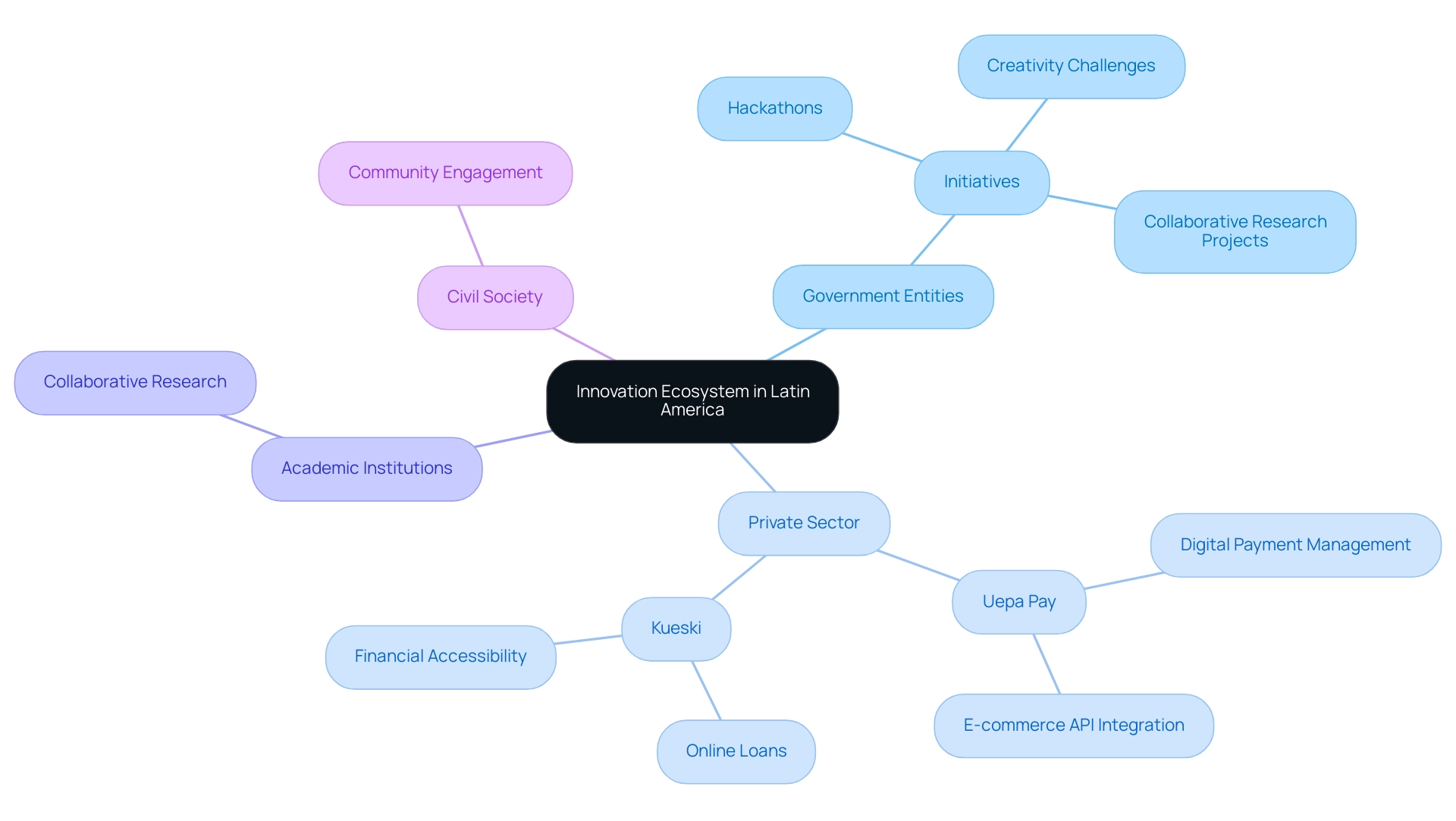
Conclusion
Latin America's innovation landscape is undergoing a significant transformation, driven by technological advancements, an entrepreneurial spirit, and supportive government policies. The region is emerging as a global player, particularly in clinical research, with initiatives like bioaccess™ enhancing healthcare delivery and streamlining trials. The rise of tech startups, particularly in Brazil, Mexico, and Argentina, reflects a robust ecosystem that is responding to pressing social and economic challenges, including the needs of an aging population.
Connectivity remains a crucial factor in this evolution, with projects aimed at bridging the digital divide empowering individuals and businesses alike. Improved internet access is not only facilitating educational opportunities but also enhancing healthcare delivery through telemedicine. As Latin America invests in technology and education, it is nurturing a workforce equipped to thrive in a digital economy, fostering innovation and economic growth.
Moreover, the collaboration among stakeholders—governments, private sectors, and academic institutions—is vital in building a sustainable innovation ecosystem. These partnerships drive initiatives that enhance financial inclusion, improve public health, and stimulate economic opportunities across various sectors. As the region harnesses its rich natural resources and innovative potential, it is poised to become a leader in both economic resilience and environmental sustainability.
In conclusion, the convergence of these elements positions Latin America at the forefront of global innovation. By continuing to foster collaboration and embracing technological advancements, the region can unlock new opportunities, enhance the quality of life for its citizens, and secure its place as a competitive player on the world stage. The future of innovation in Latin America is bright, promising a more connected and prosperous tomorrow.
Frequently Asked Questions
What are the main drivers of innovation in Latin America?
Innovation in Latin America is driven by technological advancements, a growing entrepreneurial spirit, and proactive government policies.
Which countries in Latin America are experiencing a surge in tech startups?
Brazil, Mexico, and Argentina are witnessing a notable increase in tech startups.
How is the region positioning itself in clinical research?
Latin America is becoming a strong competitor in clinical research, with initiatives like bioaccess™ establishing partnerships to enhance clinical trials, particularly in Colombia.
What is the significance of the partnerships established by bioaccess™?
These partnerships aim to position Barranquilla as a leading location for clinical trials, improve AI-based disease detection, and enhance clinical trial services, resulting in reduced recruitment times and high retention rates.
What demographic trend in Latin America highlights the need for innovation?
By 2053, the percentage of the population aged 65 years and older is projected to reach 20.6%, necessitating innovative healthcare solutions.
How are successful tech startups addressing the needs of an aging population?
They are developing innovative solutions in healthcare and technology to meet the challenges posed by an aging demographic.
What role does connectivity play in innovation in Latin America?
Technological advancements in connectivity are essential for bridging the digital divide, enabling access to information, collaboration, and integration into the global economy.
What initiatives are improving internet access in underprivileged areas?
Projects like Amazon's Project Kuiper are set to provide reliable, high-speed internet access, empowering communities and enhancing digital engagement.
How does improved connectivity impact education and healthcare?
Enhanced internet access facilitates online educational resources and telemedicine, leading to better educational outcomes and improved patient care.
What are the broader implications of addressing the digital divide?
Closing the digital divide fosters sustainable growth across various sectors and ensures that all communities can participate in the digital age.
Why is reliable connectivity crucial for research and data collection?
Reliable connectivity is essential for accurate data collection and analysis in clinical research, impacting the quality of findings and overall research outcomes.




